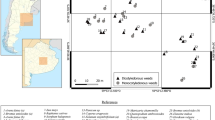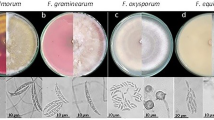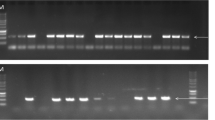Abstract
In the conducted studies 13 species ofFusarium were isolated into pure culture from triticale seed. Their pathogenicity was assessed under laboratory and greenhouse conditions. Most of the species studied were highly pathogenic to the first leaf see-dlings of triticale ‘Grado’ and ‘Lasko’ under both sets of conditions. It was shown, that seed-transmitted Fusarium spp. considerably reduced the ability of seeds to germinate and incited seedling blight. On average, triticale ‘Lasko’ was more resistant toFusarium spp. than ‘Grado’, but in some instances a reverse reaction was observed.
Similar content being viewed by others
References
Bateman G.L. 1979. Relationships betweenFusarium nivale and other microorganisms on seed of wheat and barley. Trans. Br. mycol. Soc. 72: 245–249.
Chelkowski J. and Nanka M. 1983. The ability ofFusaria pathogenic to wheat, barley and corn to produce zearalenone. Phytopath. Z. 106: 354–359.
Chelkowski J., Golinski P., Manka M., Trojanowska K., Wiewiorowska M. and Szebiotko K. 1983. Mycotoxins in cereal grain. Part IX. Zearalenone and Fusaria in wheat, barley, rye and corn kernels. Die Nahrung 27: 525–531.
Chelkowski J., Manka M., Golinski P. and Visconti A. 1985. Pathogenicity ofFusarium avenaceum isolates from cereals and their ability to produce substance with yellow fluorescence. Phytopath. Z. 112: 344–347.
Chelkowski J., Manka M., Perkowski J., Kwasna H. and Visconti A. 1987. Zearalenone formation byFusarium crookwellense (Burgess, Nelson, Toussoun) isolates from Poland and their pathogenicity towards cereals. European Seminar “Fusarium — Mycotoxins, Taxonomy, Pathogenicity”, Warsaw, 8–10 Sept.: 36–40.
Chelkowski J., Visconti A., Perkowski J., Wakulinski W. and Botallico A. 1987. Mycotoxins and fungi accompanying wheat head fusariosis in Poland. European Seminar “Fusarium — Mycotoxins, Taxonomy, Pathogenicity”, Warsaw 8–10 Sept.: 57–60.
Chelkowski J., Manka M., Kwasna H., Visconti A. and Golinski P. 1989.Fusarium sporotrichioides Sherb.,F. trineinctum (Corda) Sacc. andF. poae (Peck) Wollenw. — cultural characteristics, toxinogenicity and pathogenicity towards cereals. J. Phytopathology 124: 155–161.
Grey W.E. and Mathre D.E. 1988. Evaluation of spring barleys for reaction of Fusarium culmorum seedling blight and root rot. Can. J. Plant Sci. 68: 23–30.
Kiecana I., Perkowski J., Chelkowski J. and Visconti A. 1987. Trichotecene mycotoxins in kernels and head fusariosis susceptibility in winter triticale. European Seminar “Fusarium — Mycotoxins, Taxonomy, Pathogenicity”, Warsaw, 8–10 Sept: 53–56.
Lacicowa B. and Kiecana I 1986. WystepowanieFusarium nivale (Fr) Ces. na pszenzycie i podatnosc roznych rodow hodowlanych na porazenie. Rocz. Nauk Rol., Seria E, 16: 139–150.
Manka M. and Chelkowski J. 1985. Phytotoxicity and pathogenicity ofFusarium nivale towards cereal seedlings. Phytopath. Z. 114: 1–5.
Manka M., Chelkowski J., Brayford D., Visconti A., Kwasna H. and Perkowski J. 1989.Fusarium graminearum Schwabe (teleomorphGiberella zeae Schw. Petch) — cultural characteristics, pathogenicity towards cereal seedlings and ability to produce mycotoxins. J. Phytopathology 124: 143–148.
Stack W.R. and McMullen P.M. 1985. Head blighting potential ofFusarium species associated with spring wheat heads. Can. J. Plant Pathol. 7: 79–82.
Sturz V.A. and Johnson W.H. 1983. Early colonization of the ears of wheat and barley byFusarium poae. Can. J. Plant Pathol. 5: 107–110.
Szyrmer J., Grzelak K. and Szczepanska K. 1975. Investigations on the germination capacity and mycoflora of seeds of winter triticale forms. Hod. Roslin, Aklim. Nasien. 19: 74–88.
Szyrmer J., Grzelak KL. and Szczepanska K. 1978. Experiment on germinating capacity and mycoflora of seeds of spring forms of triticale. Hod. Roslin, Aklim. Nasien. 22: 233–249.
Uoti J. 1986. The effect of fiveFusarium species on the growth and development of spring wheat and barley. Ann. Agric. Fenn. 15: 254–262.
Wilcoxson D.R., Kommendahl T., Ozmon A.E. and Windels E.C. 1988. Occurrence ofFusarium species in scabby wheat from Minnesota and their pathogenicity to wheat. Phytopathology 78: 586–589.
Author information
Authors and Affiliations
Rights and permissions
About this article
Cite this article
Arseniuk, E., Scharen, A.L. & Czembor, H.J. Pathogenicity of seed transmittedFusarium spp. to triticale seedlings. Mycotox Res 7 (Suppl 2), 121–127 (1991). https://doi.org/10.1007/BF03192196
Issue Date:
DOI: https://doi.org/10.1007/BF03192196




